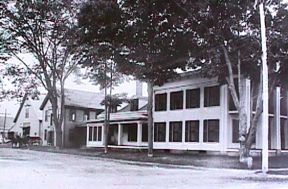
|
William Rockwell Clough |
From 1920

Clough's second wife Nellie carried on the business for many years following her husband's death. As the Alton plant on Factory Street was located just beside their Grecian-Victorian residence she managed to run her home, operate corkscrew machines when required, and still administer the business throughout the prohibition years.
In 1930, the corkscrew factory narrowly escaped major damage, when the Davis Shoes factory located across the street, was destroyed in a massive fire, which claimed the life of Mrs. Oscar Davis. The year 1930 was not a very good year, but the Clough family factory in the big red barn produced between 40-50 million corkscrews.
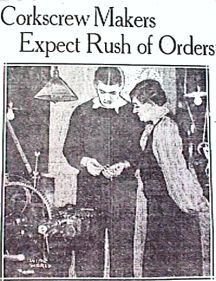 |
A post prohibition Wine World article pictures Mrs. Nell Clough and her son, in the factory in Alton. With the return of alcohol the Cloughs expected a boom in business. The factory had 18 machines which, when running at capacity, could produce 100 gross (14,400) each per day. Hennessy Three Star Brandy was one of the biggest customers of the little Alton factory along with Harvey's Shooting Sherry and Harvey's Hunting Port.  |
Several newspaper articles of the time, which focus on the life of Mrs. Nell Clough, provide interesting facts on the corkscrew business.
An article in the Boston Globe of September 29, 1931 indicated Clough Manufacturing was a prosperous and thriving business, with an annual maximum operating capacity of over 61,000,0000 corkscrews. One machine was dedicated to producing 3000 gross of nickel-plated corkscrews for China. Another produced 15,000 gold plated corkscrews per day for a cologne manufacturer. Various newspaper articles indicate that the Alton factory filled orders for Africa, Australia, Canada, China, England, Italy, Scotland and the Philippines. One British railway company alone, who operated 18 hotels in Scotland and England, ordered 1,000,000 corkscrews.
In a Boston Globe article of September 31, 1931 Nell Clough (stating firmly that the family name Clough was pronounced Cluff not Clow) said "Prohibition hit the business with quite a wallop when it practically wiped out the American market for the Clough corkscrew" but she added "for two years after prohibition went into effect business was better in Alton than before prohibition. That is attributed to the widespread drinking of medicinal concoctions and extracts containing a high percentage of alcohol. Everybody in the United States seemed to be in need of a corkscrew. But there has since been a gradual decline, with but few orders in this country for the heavy corkscrews for pulling corks from quarts and pints." It is interesting to note that one newspaper article of the period stated that a popular Prohibition epigram was "An optimist is a man who carries a corkscrew".
The same article gives a laymen's description of the 1900 patent corkscrew manufacturing machine - "A coil of steel wire on a spool is threaded into a machine, somewhat as one would thread a sewing machine. This remarkable invention then cuts off pieces of wire, the proper length for the corkscrew. A whirling gadget seizes one end of the wire and twirls it into the proper spiral shape, pointed at the business end. Another gadget twirls the other end of the wire at the same time, forming a circular handle through which you may insert your finger to pull the cork. And a third gadget tosses the finished product into a bucket or a zinc washtub where the corkscrew is rather warm to the touch after the mauling by the machine. In the same time it takes to read this so called description the machine would spit out a couple of dozen corkscrews. The machines which turn out the little wire handled corkscrews produce 15,000 a day. The machines which fashion the heavier corkscrews used for beverage purposes have an output of 8,000 a day".
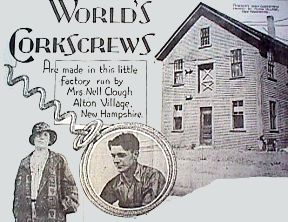 |
A piece in The Worcester Telegram of Sunday August 28,1932, claimed that 90% of the worlds' corkscrews were manufactured by 'The Corkscrew Lady-Mrs. Nell Clough'. According to this paper, the world was once more clamoring for corkscrews. A photograph shows Nell Clough and son William Rockwell Jr. referring to them as the Superintendents of America's only factory devoted exclusively to the manufacture of corkscrews. Note that William's head is pictured inside a 1900 patent corkscrew finger ring, with the modest sized Clough factory on the right. The Alton factory made more than 30,000,000 corkscrews that year, utilizing 17 corkscrew manufacturing machines several of which turned out 1000 per hour. |
|
The plant was later managed by William R. Clough Jr. It had become unprofitable and changed from manufacturing complete corkscrews, to making screw/helixes to be assembled by others. Although patented staples had been added to the corkscrew line, they were not enough to make the business viable. In the mid 1930's the business was closed. Upon its closure it seems that the heavy machinery was sold as scrap to the Japanese, who in the 1930's were avidly seeking such throughout the United States. The Clough Residence was later converted to a restaurant and inn known as The White Lodge by Mildred and Norman Griffin and started business as such on June 13, 1952. |
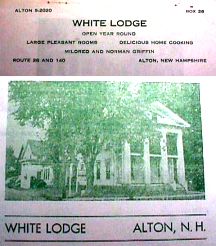 |
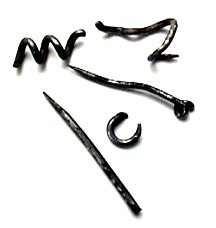 |
On August 18, 1972 Bob and Peggy Nugent visited the old Clough Factory, which was then used to make Profile ski jackets. Bob used his penknife to remove "bits of wire from corkscrews" from the cracks in the wooden floor of the old factory in Alton, New Hampshire. Bob kept the wire pieces in a pill bottle along with a dated description of their visit to the site. Needless to say Bob & Peggy dined at The White Lodge that day. It still stands at the junction of Route 140 and Route 11 and is now once again used as a family residence. |
Nellie Clough died on May 24, 1960. Colonel William R. Clough Jr. (USAF Retired), died January 14, 1983. Sadly the former factory building was totally destroyed by fire on June 30, 1985.
©2002, 2003 Ron MacLean
Book Designer and Webmaster: Donald A. Bull